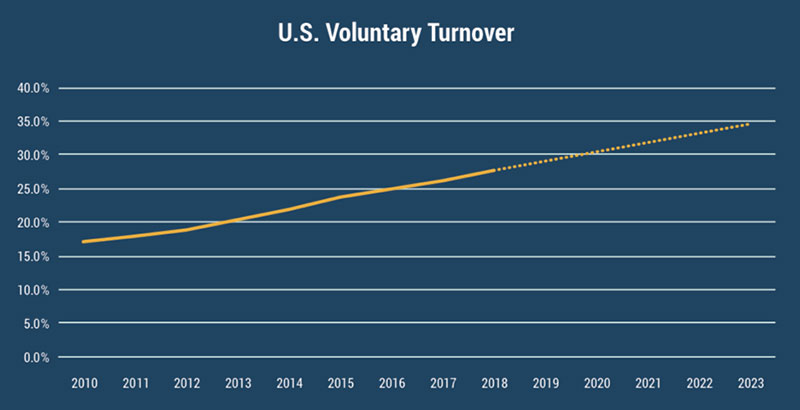
In April 2019, the unemployment rate in the US fell to 3.6% – the lowest it has been since December 1969.
While a healthy job market is of course desirable, it does also expose employers to a greater risk of losing high performers to competitors offering higher salaries, better benefits and more enticing company cultures.
A worrying trend
Looking at the numbers, the risk is such that employers should take note. According to The Work Institute 2019 Retention Report, voluntary turnover is on the rise in the US. In 2018, it exceeded 27% nationally, with 41.1 million US workers voluntarily leaving their jobs. Turnover trends reveal an 88% increase since 2010 and if this continues, voluntary turnover will reach 35% by 2023.

Counting the cost of voluntary turnover
The Work Institute conservatively estimates that losing a US employee costs $15,000. Further, the company reveals that since 2010, costs linked to voluntary turnover have almost doubled from $331 billion to $617 billion, and if the trend doesn’t change, the number could be $800 billion by 2023.
What strategy can be followed for turnover prevention?
Fortunately, there are actions that companies can take to discourage the trend. This three-part formula outlines a few practical but effective ways to reduce turnover.
1. Integrate
New hires quickly decide if they want to be a part of your company or not. In fact, companies lose on average 23% of new hires within a year. This is why it’s so important to establish the right tone, set employees up for success early, and build loyalty from the outset.
This can be achieved with a new hire integration plan which, in a nutshell, is a documented process that helps companies ensure that new hires are given access to the resources they need to become happy, productive and high-performing employees as soon as possible.
New hire integration differs from onboarding in that it is far more comprehensive and lasts much longer, normally between six months and two years. While this is important at all levels, great attention should be given to integrating new senior hires – here’s an outline of how that can be done.
There are also software solutions, like ours, that help you make sure that your new hires are successfully integrated. You can learn more about how to choose the right solution here.
2. Advance
High performers are motivated by far more than a great salary. They want to grow. They want to master their jobs and know that they have a solid career plan and the ability to advance at your organization.
There are a number of ways that you can help your employees to do this and therefore remain loyal. These include:
This type of planning doesn’t have to involve the (sometimes daunting) five- or ten-year plan – it can, but it can also merely involve focusing on the skills your employees would like to develop.
Real-time feedback involves regularly ‘checking in’. It shows employees that they matter, makes them feel valued, and it means that any small issues can be caught before they become huge problems.
Here’s more on how to gather real-time feedback.
Developing a culture of continuous learning and giving your employees the opportunity to develop their careers through training is a valuable retention strategy. This can easily be achieved through microlearning.
Taking on side gigs is a trend that’s becoming increasingly popular. Creating an internal gig economy lets employees take on stimulating work gigs in other departments and teams – a great way of fostering intrapreneurship and turnover prevention.
3. Include
Today’s employees care about the environment they work in. They want to be part of something good and fair. Diversity is a massive building block in the construction of the “workplace of the future” – a place that attracts high performers from all walks of life.
Of course, it’s not too enough to simply hire diverse employees. You need to have inclusion strategies in place too. Learn more about how you can create a more inclusive and empowering workplace here.
As outlined in one of our earlier blogs, when it comes to turnover prevention, diversity and inclusion (D&I) not only create a work environment that attracts and helps retain employees but actually lead to higher profitability.
Don’t lose great people to companies that tick all of these boxes – attract and retain employees with a brilliant turnover prevention strategy.